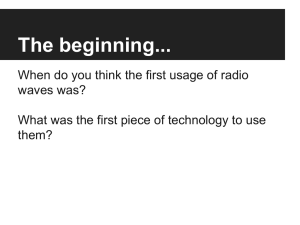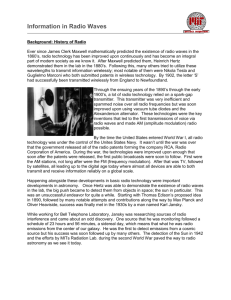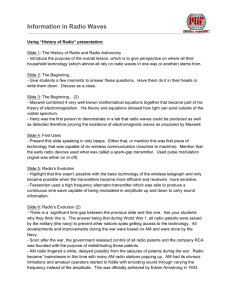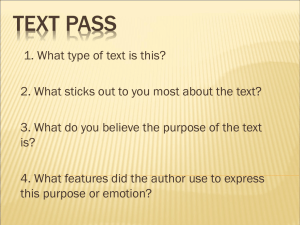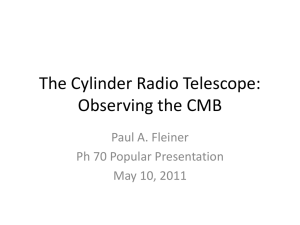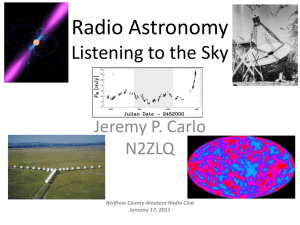pptx - MIT Haystack Observatory
advertisement
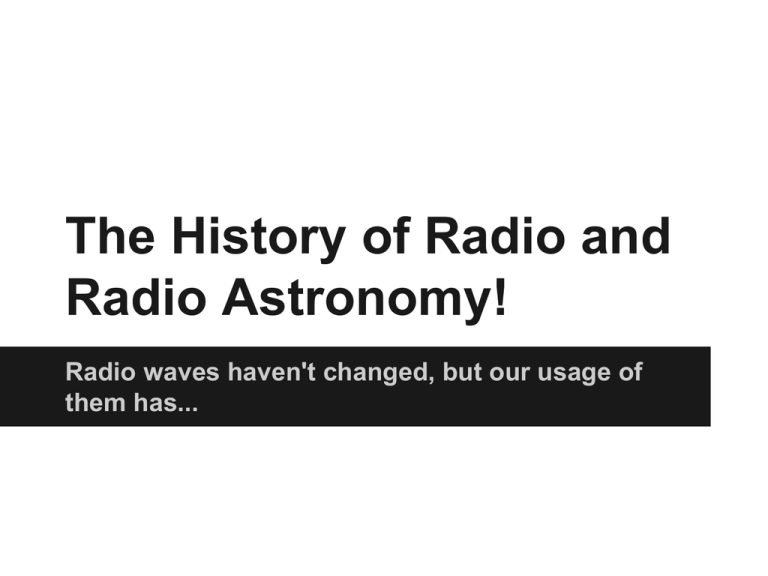
The History of Radio and Radio Astronomy! Radio waves haven't changed, but our usage of them has... The beginning... When do you think the first usage of radio waves was? What was the first piece of technology to use them? The beginning... - It all starts with math ● James Clerk Maxwell, in 1864, showed using mathematics that electromagnetic force could be propagated through free space at any wavelength o He also went on to calculate the speed of light to within 4% of what we know today! - Wasn't until 1888 that Heinrich Rudolf Hertz demonstrated in the lab that electromagnetic waves existed by producing and detecting radio waves http://www.royalsoced.org.uk/cms/images/maxwell/maxwell.jpg First uses: - Wireless telegraph o o o It is not very clear as to whom to credit with the overall invention of this device. First device to be used to successfully transmit a transatlantic message was invented by Guglielmo Marconi. Just like the regular telegraph machines, the wireless version also sent information using Morse Code. http://www.successfuloffice.com/articles/marconi-invention.gif Radio's Evolution: - Soon after messages were successfully sent via Morse code, it was hypothesized that speech information could be encoded and sent via radio waves. ● This was achieved by Reginald Fessenden by Amplitude Modulation (AM radio) in 1906 http://hyperphysics.phy-astr.gsu.edu/hbase/audio/imgaud/am.gif Radio's Evolution: - After World War I, AM Radio took off thanks to the company RCA - AM lingered around for awhile until the 1930s when amatuer radio operators started experimenting with frequency modulation o o FM Radio gets its official start in 1933 thanks to Edwin Armstrong 1938 marks the famous Orson Welles broadcast of "The War of the Worlds" http://0.tqn.com/d/webclipart/1/0/i/H/5/Alien-Night-Sky.jpg Things take off... - TV gets invented around the 50s and "Radio" starts to take a backseat ● TV broadcasts also rely on radio waves! - At this point a lot of things start to happen including the transistor radio, radio satellites, and its conversion into the digital age (all your technologies rely on the transmission and reception of radio waves!) - The important thing is how radio waves started to be used in astronomy in the 1930s... Interlude: A good breakdown of the history of Radio: http://blog.sonos.com/culture/the-history-of-radio/ Radio Astronomy: - The history of Radio astronomy again starts with Maxwell and Hertz - From these predecessors, many scientists believed they could detect radio emissions from celestial objects o 2 notable scientists who experimented with this early on were Thomas Alva Edison and Sir Oliver J. Lodge in the 1890's. http://lcweb2.loc.gov/service/pnp/cph/3c00000/3c01000/3c01700/3c01784v.jpg http://1.bp.blogspot.com/-LYdTaArmYoM/UCXu_cDeTQI/AAAAAAAACrQ/b1Rbn8vHhtA/s1600/thomas-edison-lightbulb.jpg Karl Jansky: - In the early 1930s Karl Jansky was assigned by the Bell Telephone Company to investigate sources of static that might interfere with radio transmissions. - Jansky build an antenna that detected radio waves of 20.5 MHz. http://www.nrao.edu/whatisra/images/jansky1.gif Karl Jansky cont. - Using his antenna, Jansky discovered three static sources: 1. Nearby thunderstorms 2. Distant thunderstorms 3. an unknown hiss that occurred approximately once a day.... - What was that unknown hiss? https://admissionblog.usc.edu/files/2013/05/Question-Mark.jpg Karl Jansky cont. - It turns out, the faint hiss that Jansky discovered wasn't following the 24-hr day of the sun, therefore wasn't coming from the sun. Instead it followed a sidereal day (23 hrs. 56 mins) which followed the path of a distant star o Turned out he discovered the radio emissions of the center of our galaxy o His results of this were widely publicized in 1933, but sadly he never worked in radio astronomy again o http://curiouspaul.com/you_are_here_galaxy.jpg http://d1jqu7g1y74ds1.cloudfront.net/wp-content/uploads/2010/11/milkyway.jpg Grote Reber: - Was very interested in Jansky's discovery in 1933, but was unable to get a job at an observatory due to it being the great depression - He decided that wasn't going to stop him: o Built his own (very impressive) radio telescope in his backyard http://www.nrao.edu/whatisra/images/grote6.gif Grote Reber cont. - His telescope used a parabolic dish design o Focuses all wavelengths to a single focus - After many attempts, he confirmed Jansky's discovery in 1938 - Overall, he used his telescope to chart the night sky and keep track of the "brightness" of radio waves in our galaxy o Used these to make the first "pictures" using radio waves in the form of contour maps (based on the brightness of the radiation detected) http://www.nrao.edu/whatisra/images/grote5.gif Important times in Radio Astronomy: - 1942: James Stanley Hey successfully detects radio emissions from the sun - 1944: Jan Oort and his student Hendrik C. van de Hulst predict the existence of the 21-cm hydrogen line (huge in astrochemistry) - 1951: Edward Mills Purcell and Harold Irving Ewen discover the 21-cm hydrogen line http://www.nrao.edu/whatisra/images/inspectinghorn.jpg Other important times: - In the 1940s radio interferometry was used to perform the first high resolution radio astronomy observations - 1967: First VLBI (Very Long baseline Interferometry) done by Canadian and U.S. researchers o From this point it was realized VLBI could be used to perform many useful tasks in radio astronomy - From this point on, VLBI has been on the dominant techniques in the field of radio astronomy as it allowed for greater and greater resolution as the baselines became greater and greater More Dates: - 1963: the largest radio telescope to date is built in Arecibo, Puerto Rico (1000-ft. aperture) http://www.cv.nrao.edu/course/astr534/images/Arecibo.jpg More Dates: - 1966 and 1967: Shapiro's 4th test o The '4th' test of Einstein's general relativity done at Haystack Observatory http://upload.wikimedia.org/wikipedia/commons/thumb/2/24/Cassini-science-br.jpg/250px-Cassini-science-br.jpg The VLA: http://upload.wikimedia.org/wikipedia/commons/6/63/USA.NM.VeryLargeArray.02.jpg Local Efforts: - A lot of improvements in radio astronomy wouldn't have happened if it wasn't for the efforts of MIT's Radiation lab during and after WWII o Before, during and after the war, the military invested a lot of research money into the development of better radar systems. Local Efforts continued: - These two sources do a good job showing the role MIT's Rad lab played in the war efforts: 1. http://www.ll.mit.edu/about/History/RadLab.html 1. http://www.ieeeghn.org/wiki/index.php/Milestones:MIT_Radiation_Lab oratory%2C_1940-1945 Post-War efforts: - During the Cold War, great emphasis was placed on long range detection of ICBMs At the time, radar only worked a maximum distance of the horizon o Made it necessary for much longer range of detection o Military again gave much of the refining work to MIT, this time at Lincoln Labs: http://www.ll.mit.edu/about/History/SAGE_TOCpage.html o How research is done: - The previous links are perfect examples of how research is done in the scientific community: o o The government / military see shortcomings in technology Research money is given out to figure out how to improve the technology (the more pressing, the more money) rinse and repeat... Example: - Military needs a longer range radar for ICBM detection: o Lincoln Labs given R&D money and develops SAGE - Military notices a lot of false alarms due to ionosphere and auroras: o MIT finds out what is causing these and figures out how to fine-tune the system - The improvements not only beneficial for the military, but for the scientific community as a whole There is so much more... But not enough time to cover it all! If you are interested, look up research done in: - Incoherent Scatter Radar (Space Weather) - Sgr A* or NGC4258 (Black Holes!!!!) / - Event Horizon Telescope - Geodesy (plate tectonics) - VLBI - Astrochemistry (spectroscopy, chemicals in space, etc.) - MASERs (basically radio lasers, everyone loves lasers!)
